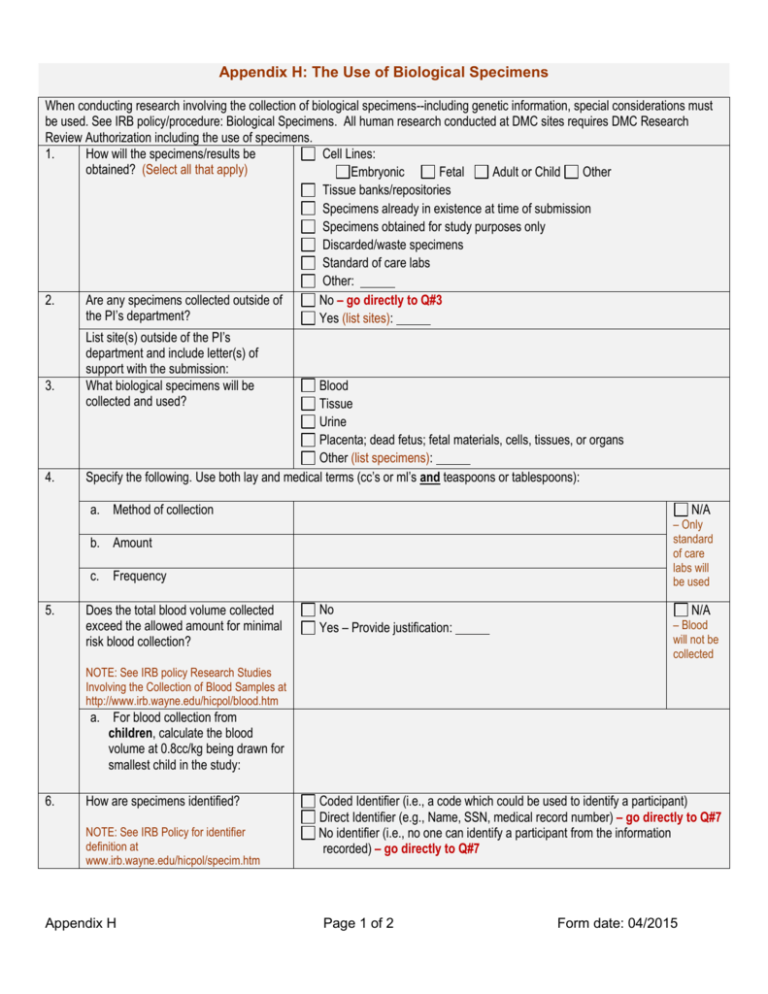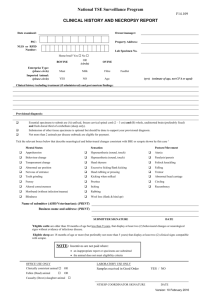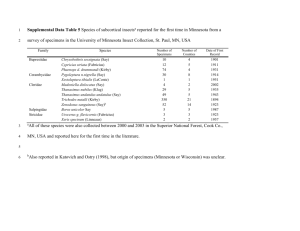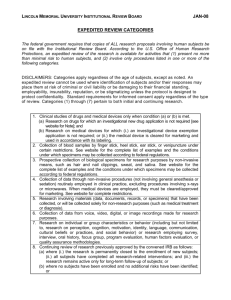Appendix H - The Use of Biological Specimens
advertisement

Appendix H: The Use of Biological Specimens When conducting research involving the collection of biological specimens--including genetic information, special considerations must be used. See IRB policy/procedure: Biological Specimens. All human research conducted at DMC sites requires DMC Research Review Authorization including the use of specimens. Cell Lines: 1. How will the specimens/results be obtained? (Select all that apply) Embryonic Fetal Adult or Child Other Tissue banks/repositories Specimens already in existence at time of submission Specimens obtained for study purposes only Discarded/waste specimens Standard of care labs Other: No – go directly to Q#3 2. Are any specimens collected outside of the PI’s department? Yes (list sites): List site(s) outside of the PI’s department and include letter(s) of support with the submission: Blood 3. What biological specimens will be collected and used? Tissue Urine Placenta; dead fetus; fetal materials, cells, tissues, or organs Other (list specimens): 4. Specify the following. Use both lay and medical terms (cc’s or ml’s and teaspoons or tablespoons): a. Method of collection N/A – Only standard of care labs will be used b. Amount c. Frequency 5. Does the total blood volume collected exceed the allowed amount for minimal risk blood collection? No Yes – Provide justification: N/A – Blood will not be collected NOTE: See IRB policy Research Studies Involving the Collection of Blood Samples at http://www.irb.wayne.edu/hicpol/blood.htm a. For blood collection from children, calculate the blood volume at 0.8cc/kg being drawn for smallest child in the study: 6. How are specimens identified? NOTE: See IRB Policy for identifier definition at www.irb.wayne.edu/hicpol/specim.htm Appendix H Coded Identifier (i.e., a code which could be used to identify a participant) Direct Identifier (e.g., Name, SSN, medical record number) – go directly to Q#7 No identifier (i.e., no one can identify a participant from the information recorded) – go directly to Q#7 Page 1 of 2 Form date: 04/2015 a. Will the research team have access to the link or the direct identifiers? Yes No – provide a letter from the holder of the link stating that the investigative team will not have access NOTE: Linkages known to the research staff must be disclosed in the informed consent form. 7. Will any of the specimens be used to identify sensitive genetic information? No Yes a. Will this identification carry significant socioeconomic risk? No Yes b. Will there be a link to participant’s identity? c. Is the link disclosed in the consent? 8. Will the specimens be stored for future use? a. Is the future use listed in the consent? 9. For studies that involve placenta, dead fetus, fetal material: cells, tissues, or organs taken from a dead fetus, will the research team have access to any identifiers.? Appendix H Risk – the probability of harm, injury, or loss (physical, psychological, social, or economic) occurring as a result of participation in a research study. Both the probability and magnitude of possible harm may vary from minimal to significant. Social risks may arise from actual or potential breaches of confidentiality or anonymity such as harm to interpersonal relationships, damage to reputation or social standing, or exposure to legal sanctions. Economic risks may affect an individual's financial status, employability or insurability. No – go directly to Q#8 Yes No Yes No – go directly to Q#9 Yes No Yes N/A No Yes – informed consent must be obtained from all individuals identified on those specimens Page 2 of 2 Form date: 04/2015






